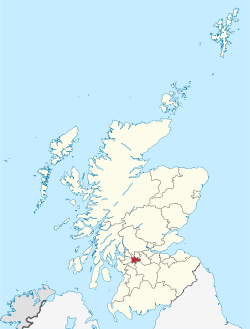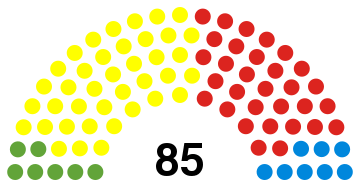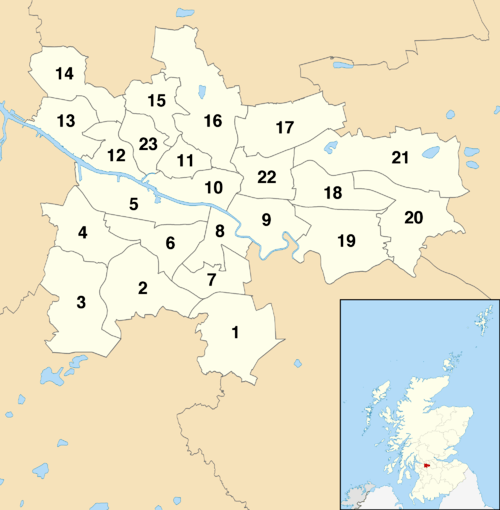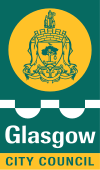Glasgow City Council
| Glasgow City Council Scottish Gaelic: Comhairle Baile Ghlaschu | |||
|---|---|---|---|
| |||
 | |||
| Admin HQ | Glasgow | ||
| Government | |||
| • Body | Glasgow City Council | ||
| • Control | SNP minority (council NOC) | ||
| Population (mid-2016 est.) | |||
| • Total | 615,100 | ||
| • Rank | Ranked 1st | ||
| • Density | 9,100/sq mi (3,520/km2) | ||
| ONS code | S12000046 | ||
| ISO 3166 code | GB-GLG | ||
| Website | www.glasgow.gov.uk | ||
Glasgow City Council, the local government body of the city of Glasgow in Scotland, became one of the newly created single tier local authorities in 1996, under the Local Government etc. (Scotland) Act 1994,[1] with boundaries somewhat different from those of the City of Glasgow district of the Strathclyde region: parts of the Cambuslang and Halfway and Rutherglen and Fernhill areas were transferred from the city area to the new South Lanarkshire council area.
The district had been created in 1975 under the Local Government (Scotland) Act 1973 to include: the former county of the city of Glasgow and a number of areas previously within the county of Lanark: Cambuslang (Central and North, and South lying outwith East Kilbride), Rutherglen (including the burgh of Rutherglen), part of a Carmunnock area (that lying outwith East Kilbride) and Baillieston, Carmyle, Garrowhill, Mount Vernon and Springboig.
History
The early city was run by the old "Glasgow Town Council". In 1895, the Town Council became "The Corporation of the City of Glasgow" ("Glasgow Corporation" or "City Corporation"). It retained this title until local government re-organisation in 1975, when it became "City of Glasgow District Council". In 1996, following the dissolution of Strathclyde Regional Council and the transfer of its responsibilities to Glasgow District Council, the authority was renamed "Glasgow City Council".
The title Lord Provost of Glasgow, used now for the civic leader of the city council, has history dating from the 15th century.
During World War I, the council was unique in the United Kingdom in appointing an official war artist, Frederick Farrell.[2]
Glasgow Corporation Transport was under the control of the Glasgow Corporation, and ran the local buses and Glasgow Trams, until it was superseded by the Greater Glasgow Passenger Transport Executive on 1 June 1973.
During the period of two tier local government (Local Government (Scotland) Act 1973), 1975 to 1996, Glasgow District Council was responsible for refuse collection, museums, libraries and housing, while Strathclyde Regional Council had responsibilities for policing, fire service, water, education, social work and transport.
The city council established in 1996 (Local Government etc. (Scotland) Act 1994), took on the powers and responsibilities previously divided between councils of the Glasgow City district and the Strathclyde region.
The council area borders onto East Dunbartonshire, East Renfrewshire, North Lanarkshire, Renfrewshire, South Lanarkshire and West Dunbartonshire.
Council Control
Current political composition
As of 4 May 2017, the council is currently composed of:[3]

| Party | Councillors | |
| Scottish National Party | 39 | |
| Labour | 31 | |
| Conservative | 8 | |
| Scottish Green | 7 | |
History of leaders and administrations
| Controlling party | Years | Leader | |
|---|---|---|---|
| No overall control | 1934–1945 | 1933 – 1934: George Smith (Labour) 1934 – 1938: Patrick Dollan (Labour) 1938 – 1941: Hector McNeill (Labour) 1941 – 1945: George Smith (Labour) | |
| Labour | 1945–1949 | 1945 – 1948: George Smith (Labour) 1948 – 1949: Andrew Hood (Labour) | |
| No overall control | 1949–1950 | 1949 – 1950: John Donald Kelly (Progressive) | |
| Progressives | 1950–1952 | 1950 – 1952: John Donald Kelly (Progressive) | |
| Labour | 1952–1968 | 1952 – 1955: Andrew Hood 1955 – 1957: Jean Roberts 1957 – 1958: Myer Galpern 1958 – 1963: Peter Meldrum 1963 – 1968: William Taylor | |
| No overall control | 1968–1969 | 1968 – 1969: John Douglas Glen (Progressive) | |
| Progressives | 1969–1970 | 1969 – 1970: Peter Gemmill (Progressive) | |
| No overall control | 1970–1971 | 1970 – 1971: Peter Gemmill (Progressive) | |
| Labour | 1971–1977 | 1971 – 1972: John Mains 1972 – 1973: Richard Dynes 1973 – 1974: Geoff Shaw 1974 – 1977: Richard Dynes | |
| No overall control | 1977–1980 | 1977 – 1979: John Young (Conservative) 1979 – 1980: Jean McFadden (Labour) | |
| Labour | 1980–2017 | 1980 – 1986: Jean McFadden 1986 – 1992: Pat Lally 1992 – 1994: Jean McFadden 1994 – 1996: Pat Lally 1996 – 1997: Bob Gould 1997 – 1999: Frank McAveety 1999 – 2005: Charlie Gordon 2005 – 2010: Steven Purcell 2010 – 2015: Gordon Matheson 2015 – 2017: Frank McAveety | |
| No overall control | 2017–present | 2017 – present: Susan Aitken (SNP)[4] | |
Council structure
 |
| This article is part of a series on the politics and government of Glasgow |
The council is ceremonially headed by the Lord Provost of Glasgow, who is elected to convene the council and perform associated tasks as a general civic leader and Lord Lieutenant. The current incumbent is Eva Bolander.
The council's executive branch is headed by a Leader of the Council, who is the leader of the largest political grouping, currently the Scottish National Party. The executive committee is usually formed of 19 members across all the elected parties proportionally, however this would have given the SNP a majority of 10 seats despite not gaining one through the election. The Greens proposed an amendment to add an additional seat for each party, making the SNP the biggest minority party.[5] It was passed and so its composition of 23 seats is currently:[6]
| Affiliation | Councillors | |
| Scottish National Party | 11 | |
| Scottish Labour | 8 | |
| Scottish Conservative | 2 | |
| Scottish Greens | 2 | |
Elections
The council consists of 85 councillors elected for a five-year term from 23 wards. These wards were introduced for the 2017 election, replacing those introduced in 2007, and each returns three or four members by the single transferable vote system of election. This system was introduced by the Local Governance (Scotland) Act 2004,[7] as a means of ensuring a reasonably proportionately representative outcome.
The most recent full council election took place on Thursday 4 May 2017. The Scottish National Party became the largest party (39) but did not gain an overall majority; Labour returned fewer councillors (31) and lost overall control, with increased numbers for the Conservatives (8) and the Greens (7).
Current multi-member ward system
A new multi-member ward system was introduced for the 2017 council election:

| Ward | Number of councillors |
|---|---|
| 1. Linn | 4 members |
| 2. Newlands/Auldburn | 3 members |
| 3. Greater Pollok | 4 members |
| 4. Cardonald | 4 members |
| 5. Govan | 4 members |
| 6. Pollokshields | 4 members |
| 7. Langside | 4 members |
| 8. Southside Central | 4 members |
| 9. Calton | 4 members |
| 10. Anderston/City/Yorkhill | 4 members |
| 11. Hillhead | 3 members |
| 12. Victoria Park | 3 members |
| 13. Garscadden/Scotstounhill | 4 members |
| 14. Drumchapel/Anniesland | 4 members |
| 15. Maryhill | 3 members |
| 16. Canal | 4 members |
| 17. Springburn/ Robroyston | 4 members |
| 18. East Centre | 4 members |
| 19. Shettleston | 4 members |
| 20. Baillieston | 3 members |
| 21. North East | 3 members |
| 22. Dennistoun | 3 members |
| 23. Partick East/Kelvindale | 4 members |
Previous ward systems
A previous multi-member ward system was introduced for the 2007 council election:
| Ward | Number of councillors | Representation (2012) |
|---|---|---|
| 1. Linn | 4 members | 2 Lab; 1 SNP; 1 Lib Dem |
| 2. Newlands/Auldburn | 3 members | 2 Lab; 1 SNP |
| 3. Greater Pollok | 4 members | 2 Lab; 2 SNP |
| 4. Craigton | 4 members | 2 Lab; 2 SNP |
| 5. Govan | 4 members | 3 Lab; 1 SNP |
| 6. Pollokshields | 3 members | 1 Lab; 1 Con; 1 SNP |
| 7. Langside | 3 members | 2 SNP; 1 Lab |
| 8. Southside Central | 4 members | 2 Lab; 2 SNP |
| 9. Calton | 3 members | 2 Lab; 1 SNP |
| 10. Anderston/City | 4 members | 2 SNP; 1 Lab; 1 Green |
| 11. Hillhead | 4 members | 2 Lab; 1 SNP; 1 Green |
| 12. Partick West | 4 members | 2 SNP; 1 Green; 1 Ind |
| 13. Garscadden/Scotstounhill | 4 members | 2 Lab; 2 SNP |
| 14. Drumchapel/Anniesland | 4 members | 3 Lab; 1 SNP |
| 15. Maryhill/Kelvin | 4 members | 2 Lab; 2 SNP |
| 16. Canal | 4 members | 2 Lab; 1 Ind; 1 Green |
| 17. Springburn | 3 members | 2 Lab; 1 SNP |
| 18. East Centre | 4 members | 2 Lab; 2 SNP |
| 19. Shettleston | 4 members | 3 Lab; 1 SNP |
| 20. Baillieston | 4 members | 2 Lab; 2 SNP |
| 21. North East | 4 members | 3 Lab; 1 SNP |
Prior to the 2007 election, there were 79 councillors elected from 79 single-member wards by the plurality (first past the post) system of election. The result from this system was 69 of the 79 councillors representing the Labour Party, although that party gained only around half the votes cast in the previous election to the council, and the Scottish National Party was represented by just four councillors, despite gaining some 20% of the votes. There were also three Liberal Democrat councillors, one Conservative councillor, one Scottish Socialist Party councillor, and one independent councillor.
| Ward | Ward | Ward | Ward |
|---|---|---|---|
|
|
|
|
Footnotes
- ↑ See also Local Government etc. (Scotland) Act 1994, Office of Public Sector Information (OPSI) website Archived 1 March 2010 at the Wayback Machine. (OPSI home page Archived 18 April 2008 at the Wayback Machine.)
- ↑ "Glasgow's forgotten war artist Fred Farrell". Herald Scotland. 24 May 2014. Retrieved 9 May 2015.
- ↑ "Political Groups"
- ↑ "Glasgow City Council on Twitter". Twitter. Glasgow City Council. Retrieved 18 May 2017.
- ↑ "Garscadden/Scotstounhill councillor to oversee all city schools as new minority SNP council takes charge". Clydebank Post. Retrieved 20 May 2017.
- ↑ "Glasgow City Council on Twitter". Twitter. Glasgow City Council. Retrieved 18 May 2017.
- ↑ See also Local Governance (Scotland) Act 2004, Office of Public Sector Information (OPSI) website
| Awards and achievements | ||
|---|---|---|
| Preceded by Durham |
LBC Council of the Year 2015 |
Succeeded by Tameside Metropolitan |
